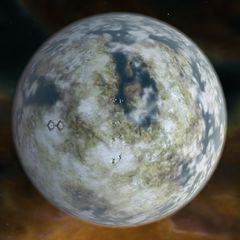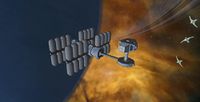
|
This wiki is closed in favour of the new wiki. Information shown is likely to be very out of date. |
Difference between revisions of "Federal Republic of Rheinland"
| Line 5: | Line 5: | ||
|image_flag = Flag-rheinlandvector.gif | |image_flag = Flag-rheinlandvector.gif | ||
|capital_base = [[Planet New Berlin]] | |capital_base = [[Planet New Berlin]] | ||
| − | |capital_system = [[New Berlin | + | |capital_system = [[New Berlin]] |
|languages = [[German]], [[English]] | |languages = [[German]], [[English]] | ||
|government_type = Theocratic dictatorship | |government_type = Theocratic dictatorship | ||
Revision as of 08:02, 15 September 2008
| House Rheinland | |||||
| Bundesrepublik Rheinland | |||||
| Capital | Planet New Berlin, New Berlin | ||||
| Official languages | German, English | ||||
| |||||
| Founded | 3 A.S. | ||||
| Controlled space | |||||
| Affiliated organisations | |||||
Rheinland, or the Federal Republic of Rheinland (Bundesrepublik Rheinland) is the title of one of the four original houses in Sirius. It's territory extends from the fringes of the Crow Nebula to the yellow clouds of the Walker Nebula, with territorial claims deep inside the nebula itself. It is a theocratic, fascist dictatorship ruled by a Kanzler as head of state and government. Rheinland sovereign territories border the systems of Sigma-13, Omega-11, Omega-7, Hudson and Bering. The state military maintains it's bases in several systems connected to Rheinland by jump holes, such as Omega-15.
History
Main article: History of Rheinland
Early periods
The Rheinland was originally the name of one of the five Alliance sleeper ships carrying colonists on their escape from the Solar System to the Sirius Sector. This single ship was containing several thousand refugees from the German part of the Alliance. The ship arrived in the Sirius sector in 2 A.S., surveying space for almost an entire year before finally landing on a cold planet that would be later christened New Berlin, the system it lied in recieving the same name. The conditions on the planet encouraged quick expansion, and Rheinland would soon begin building orbital facilities in the LaGrange points along the orbital path of New Berlin's moon, Potsdam. These facilities would later be connected to each other to form The Ring, which would be used to construct the first Rheinland ships as well as the necessary mining equipment to extract the minerals from the vast asteroid fields in the New Berlin system itself.
Rheinland Empire
The Rheinlanders would quickly establish an emergency state for themselves, in order to rapidly conduct decisions during the process of colonisation. This state, although composed of the Reichstag housing hundreds of representatives, would come to politically mimick the 19th century German Empire, thus developing a very patriotic and imperialist tendency. would quickly consider using it's vast military resources to take what they need from the GMG. With the discovery of the Stuttgart and Dresden systems, Rheinland's food problems would be a past memory, while it's mining and shipbuilding industry would completely skyrocket, eventually producing a large, but resource consuming navy. This navy was widely regarded as able to singlehandedly conquer any other house in the sector, even by outside analysts. What Rheinland did not have was the H-Fuel required to effectively maintain such a navy. The Kruger Minerals operation in Sigma-13 that has been positioned beside the GMG was quickly running out of space, as the fiercely independent Guild grabbed as much space as it could and protected it from Kruger advances.
Eighty Years War (589-668 A.S.)
Ineffective tactics against the fast guerilla strikes of the GMG have rendered the Rheinland Military unable to hold it's ground in the low physical and sensor visibility Sigma-13 system, while also unable to progress further due to the diplomatic issues of breaching Kusari space. This allowed the Guild to using their advantage of mobility to steadily pound away at the Rheinlanders, until the defense lines began to collapse. The culmination of the war occured in 668 A.S. as the last standing battlegroup of the Rheinland Military charged into Sigma-13 in a last ditch attempt to take the system once and for all. They were met by a sizable force of Guild fighters, which slowly reduced the entire fleet to rubble, effectively ending the war in a decisive victory. Rheinland was left battered and weak, it's economy and government collapsing in on itself. With it's industries surviving only due to a large loan given by Liberty, and the Rheinland currency suffering from extreme devaluation as a result, the house was on the brink of no less than open revolution.
Popular Revolution (672 A.S.)
On Von Rohe's Day, 672 A.S., Daumann mining stations in Dresden were seized and locked down by miners in a widespread general strike. Supplied by Bundschuh revolutionaries, the miners managed to hold out on the station for weeks before word finally got out to the rest of Rheinland. Three months later, sympathetic workers disable other Daumann facilities on Planet New Berlin, joining in the protests. With the industrial heart of the economy grinding to a halt, riots beginning to pop up all across Rheinland, the government is finally forced to give in. The Bundschuh movement is publically recognised, and it's representatives meet with the imperialists soon after. A period of tense negotiations follows, and a coalition government is eventually formed. In the same year the Kaiser would officially step down from his office, and the former empire would now become a federal republic.
Federal Republic of Rheinland
Although with far more significance placed on the Reichstag, the Republic was still very dependent on a central position of power, in this case - a Chancellor. The eighth century would mostly be synonymous with the slow rebuilding of the Rheinland economy, as well as the eventual expulsion of the Bundschuh from the parliament, and the formation of several strong partisan and criminal movements that would plague the state with their activity for decades to come.
At the end of the eighth century, a group of Rheinland researchers in the Omicron systems would stumble upon a most extraordinary cache. Alien artifacts would be recovered by the hundreds, and transported back to the core worlds where they would be contested by both researchers and rich collectors. It would also be the beginning of the Nomad infestation in Rheinland, which would eventually reach Chancellor Niemann himself, and signal the beginning of the second large scale conflict in Sirius.
Nomad War (800-801 A.S.)
At the start of the ninth century the other three houses would be alarmed with the quick transition of the Rheinland republic into a de facto police state. Rheinland Military forces would be sighted as far as California and Tau-29, engaging both Liberty and Bretonian personnel seemingly at random. The war itself would begin in earnest at the time of the Rheinland invasion on Kusari, where almost half the rebuilt Rheinland navy had been infested by the Nomads and had attacked Honshu through Sigma-13.
During the large battle between the two fleets, the freelancer known as Edison Trent would decisively defeat the Nomads by cutting their source of power, thereby freeing the rest of Rheinland. The remaining infested ships in Kusari would withdraw, and would later become known as the Wilde.
Present day
In 813 A.S. Nikolaus Reinhardt attained power in Rheinland, eventually transforming the government into an fascist police state. New production plans would revive the military, while the state would begin gearing for a new period of hostilities, this time against Liberty itself.
Controlled and contested space
The Federal Republic consists of six star systems (New Berlin, Frankfurt, Stuttgart, Dresden, Munich, Hamburg), four of those containing a habitable planet (New Berlin, Stuttgart, Munich, Hamburg). Each planet is under the direct supervision of a planetary governor, although still being officially controlled by the central Rheinland state, and the Kanzler.
Territorial claims
Rheinland Military units can be encountered in the Bering and Omega-7 systems, supervising trade and conducting patrols. There is also a battleship (Schwerin) stationed in Omega-15, right next to the jump hole to Dresden. The trade lanes in Omega-7 are broadcasting a Rheinland Police IFF, indicating a degree of direct state control, despite the still official independent status of the system. Claims in Sigma-13 have been withdrawn following the conclusion of the Eighty Years War.
Government and politics
Rheinland is formally a federal republic, wherein the Chancellor is the head of state and government, while the Reichstag is a collection of representatives from all the member planets, and rules with legislative power. In reality, Chancellor Reinhardt controls the legislative and executive branches of the government, while the Reichstag representatives are mostly figureheads and KDGA members, although still allowed to submit new laws for voting. As such, Rheinland's government is centralised around the planet New Berlin, with all important decisions required to be ratified by the Kanzler before actually being put into effect.
Each system regarded as part of the Republic has a governor elected to oversee it's economy and morale. In the case of systems with a habitable planet, a governor is generally chosen from the local population, while systems with no population centres will be ruled by a government elected governor who will maintain office on New Berlin. Governors have the right to submit reforms to the Kanzler's office for consideration, thus giving Reinhardt higher legislative power over the individual planets. Each governor however has direct control over all bases and planets in the system he has been assigned to. All elected governors are members of the KDGA, and are required to pledge their allegiance to Reinhardt himself before being handed the governor's sash.
The governor of New Berlin itself is chosen only by the Kanzler, and is assigned a honourary title of High Governor on election.
Economy
The economy of the Federal Republic can neither be classified as a free-market nor a state controlled one. It revolves around the few major industrial and trade giants with their considerable stake in the industry, who are for the most part autonomous from the government, but also can be instructed by it to fulfill a particular plan. During Reinhardt, small businesses particularly suffered due to his policy of subsidies for corporations such as Republican Shipping and Kruger Minerals.
Rheinland is particularly reliant on the export of diamonds, with vast mining enterprises in Dresden and Omega-11. Daumann Heavy Construction also operates a number of stations in Omega-7 and Omega-3, mining copper, cobalt and hydrocarbons to fuel the shipbuilding industry. Leipzig Station is crucial to processing the minerals into high-temperature alloys. Niobium is also a key ingredient, and is imported from Kusari. Rheinland's territory does not incorporate any gaseous nebulas rich in H-Fuel components, and after the 80 Years War problems with obtaining H-Fuel have escalated. A large part of the Rheinland industry is dependent on Mannheim Station, which synthesizes H-Fuel from particles mined from the gas giant Heidelberg. The other part of the demand is satisfied by Kusari shipping, reselling H-Fuel obtained from Kishiro Technologies to Rheinland.
Foreign relations
The state maintains steady diplomatic relations with Kusari and Bretonia, allowing trade to pass freely through it's territories. Since the beginning of Reinhardts rule, relations with Liberty have deteriorated however, as New Berlin publically published results of an investigation aimed at Libertonian research on alien technology. All material trade between Liberty and Rheinland has since been banned by the two houses, and police forces actively search all vessels passing through from Bering and Hudson for any imported cargo. Rheinland is currently especially friendly with Kusari, due in part to their reliance on Kusarian H-Fuel, as well as their less than stellar view of Liberty.
Crime and dissent
Rheinland is duly noted for it's large and organised unlawful groups, primarily formed of revolutionary, political and reactionary factions. These factions are known to cooperate with each other on many occasions, tied together in their fight against the government. Aside from their political agenda, the Red Hessians and the Unioners are known to be involved in a large scale diamond smuggling operation.
There are four recognised unlawful factions in Rheinland:
- Red Hessians are by far the biggest of them all, known to have bases as far as in the distant Omega systems bordering Bretonian space. Due to their intake of Rheinland dissenters of all kind, they are known as the third largest unlawful group in Sirius, right after the warring Hispanian states in the Omicron systems. The Hessians are composed primarily out of disgruntled miners and workers of the Dresden system, and are frequently seen in the Stuttgart and New Berlin area. They maintain a significant presence in Omega-11 and Dresden.
- The Bundschuh were an actual political party before being declared as "enemy of the state" by the government in 700 A.S. They are the smallest unlawful group in Rheinland, and maintain their recruiting largely from the more idealistic Hessians. The Bundschuh are known to maintain their presence in New Berlin, Frankfurt and Munich.
- The Landwirtrechtbewegung are the radical element of the Stuttgart Farmers Party (SVW), which took to direct attacks against Synth Foods, Inc. when the Rheinland government gave Stuttgart away to the company. They are a relatively small faction, surviving mainly due to their close supply ring with the Hessians. They carry out their attacks in Stuttgart and New Berlin.
- Unioners are the second largest unlawful faction in Rheinland, composed primarily of the former Alster Union shipyard workers, which took to violent reprisals against Republican Shipping after the Popular Revolution started. They are known to operate from outside the borders of Rheinland into the very heart of it, extending from Bering, Hudson and Hamburg to New Berlin and Frankfurt.
Rheinland unlawfuls are known for their strong nationalism, frequently attacking hostile foreigners over possible military and police targets. Several incidents of military and unlawful cooperation against Corsair attacks have been noted, but the government is quick to dismiss such occurences as rumours and hearsay.




